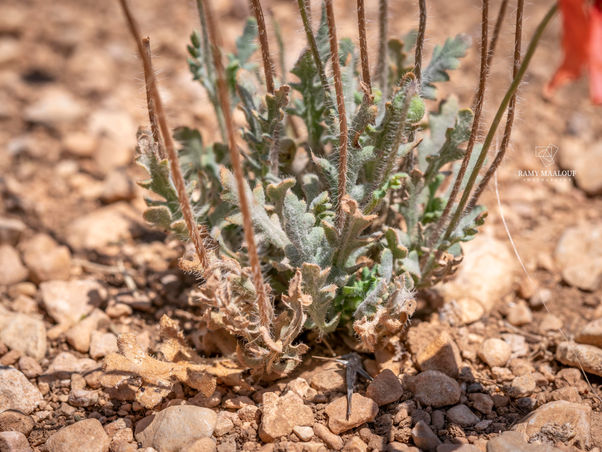Family |
papaveraceae
Papaver polytrichum
Boiss. & Kotschy
Leb. Syr.
Papaver polytrichum Boiss. & Kotschy
First published in Diagnoses Plantarum Orientalium, ser. 2, 5: 14 (1856)
• Life-form & habit: Annual poppy with erect stems densely covered in long spreading bristles; peduncles equally hirsute. Leaves lanceolate, deeply dentate, the dense bristly indumentum giving the whole plant a distinct greyish, canescent appearance.
• Inflorescence & flowers: Petals vermilion to bright red, always unspotted (Boissier: “petalis… immaculatis”; Mouterde: “sans tache noire basale”). Calyx hairy. Stamens with short, ovate anthers, a key character separating it from P. rhoeas and P. umbonatum.
• Fruit: Capsules oblong, resembling those of P. syriacum; stigmatic rays recurved over the capsule; disc flat or slightly convex.
• Phenology: Spring.
• Habitat & elevation: Montane and inland slopes, open stony ground, and dry internal valleys.
• Lebanese distribution: Anti-Lebanon and Mount Lebanon interior: ʿAïn Deheb, Jabal Kneissé, Chtaura, Ouadi el-Harir, and adjacent upland sectors (Mouterde).
• Native range: Lebanon, Syria.
• ⚠️ Taxonomic note:
– Listed by POWO as a synonym of Papaver rhoeas subsp. polytrichum (J.Thiébaut; Mém. Inst. Égypt. 31: 42, 1936).
– Records from Turkey are erroneous, confirmed by Turkish floristic checklists and Euro+Med PlantBase.
– Records from Palestine/Israel and Jordan are also incorrect, referring to other red poppies with basal black spots (likely P. umbonatum or P. hybridum). True P. polytrichum has strictly unspotted petals and a dense greyish indumentum, making the species a genuine Lebanon–Syria endemic.


